What a week. What a world. It can be difficult to think about the garden what with one banner headline in the newspaper after another. On the other hand the garden and garden catalogues provide a source of sanity. Look at this brand new coneflower.
We have been staring at lower 30 degree temperatures for this weekend all week. Tonight it could get down to 33-34 degrees depending on who you listen too. I think that temperature will be in the proverbial 'low lying areas' on the edge of town. Once we get past that tonight the next ten night-time temperatures are supposed to stay above 45. It is also suppose to be sunny.
There is lots of garden time left this year.
In our garden the great "Migration" has begun.
Each year at this time so many plants head inside. I have started the migration list. At the beginning I just list the type of plant - orchid. I then will count them as them come inside
The first plants to come in were the small hoyas. One of those is called "Red Buttons". I got that when it was small. It has grown a lot. Now I wait for the first bud to form. The biggest hoyas including the 2 from my mothers house may come in today. Sometimes a plant takes cover in a garage but just for a night. Then it goes back for a while. I might do that tonight.
Harvesting has begun.
The City is pushing everyone out of the rented garden plots this weekend. I guess some schedule for cleanup is more important that allowing my peppers to keep going to frost. So I picked the peppers and more importantly dug the amaryllis bulbs. They were growing in the sun all summer. Several wound up under the parsley. Who knew how fast parsley would grow?
I tried to grade them by size. Many of the smaller ones were side shoots at one point. They might need a few years of summer sun.
Now they need to dry, I will then store them in a cool dark dry place for at least two months. The biggest bulbs should be ready to bloom whenever I want them to break dormancy. Sometimes I try to make them stay dormant long enough to allow them to bloom in the springtime.
Here is an example of one bulb that grew side shoots over the summer.
In the process of bringing in plants I sometimes have plants that need repotting.
This is a lovely orchid that bloomed like crazy last December. Its name is Coelogyne viscosa. You need not try to remember the name. I do not.
First I got the entire plant out of the old pot and start dividing. I had to use a knife.
There were then 5 plants to come inside. I have no idea whether any of them will bloom this year.
Toad lilies for the fall
One of the plants for color in the fall garden is toad lilies. As people come visit the garden I find that very few know about these wonderful plants. I read a garden magazine recently that listed the 20 plants for fall color. This plant was not listed.
I thought I would write about toad lilies. To start with the genus is called tricyrtis.
It is interesting the questions google asks about tricyrtis.
1- Is it invasive? No
2- Is it poisonous? Yes
3- Do rabbits eat toad lilies? Sometimes, but deer do not like them.
Actually what it said was that deer do not prefer toad lilies. That is an interesting turn of phrase. If a deer has a daylily on one side and a toad lily on the other which would get eaten first? I can speak from experience that the deer did take off the top 8 inches of one of my toad lily clumps this year in August. That cropped plant is blooming now without apparent effect. I also have some deer visiting these days. They munched on some Persian Shield the other day. They are leaving the toad lilies alone.
More information can be found at:
https://www.plantdelights.com/blogs/articles/tricyrtis-toad-lily-bulbs-hirta
https://en.wikipedia.org/wiki/Tricyrtis
Several other toad lily observations.
They come in different colors. I have a yellow flowered one. As with many unusual colors it is not as vigorous as what I refer to as the regular ones. Of course it also could be the fact that it grows under the walnut tree. There is the suggestion that the walnut tree is not good for plants. I have mostly not found that to be the case with most of my plants. But who knows.
There is a white flowering one I want to obtain.
The foliage can be yellow, or slightly variegated.
The clumps get large. I have 2 clumps that are maybe 3-4 feet across. They get to be about 3 feet tall.
They can bloom so late in the year that they get toasted by a freeze before they hav finished blooming.
It is also the time of year to order plants, mostly bulbs.
I discovered yesterday that it was not too late to order epimedium. I grow them but have not really obsessed about them for maybe ten years. I learned yesterday that I could order them until October 15. So there went an hour, figuring out what I had and what I had passed over 5-10 years ago. So I think I am going to get seven new varieties if they still have them. I will then have about two weeks to figure out where I would plant them.
One thing some epimedium plants do is put on a fall display in their leaves.
This is Thunderbolt.
I remember how in the spring the color of the flowers becomes heightened by the brown of the leaves and the ground. That has started again.

Here are the ingredients: 4 chicken thighs; 1 can of artichoke hearts (frozen would be fine too); an 8 oz package of mushrooms, cut into quarters (I had cremini, white button would be fine); 2 tablespoons of butter; 2 tablespoons of flour; 3 tablespoons of dry sherry (if you have it, which I did, but it is not essential); 2/3 cup chicken broth or stock (I used bouillon); 1 teaspoon of salt; 1 teaspoon of pepper and 1/2 teaspoon of paprika.
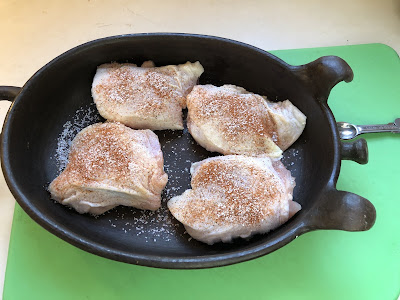
I mixed up 1/2 teaspoon each of salt and pepper and paprika and sprinkled it on the chicken on both sides. Then I put the chicken pieces in a un-lubed baking dish and set it aside.
put the baking dish of chicken in the oven to get a head start.



Time to assemble. I took the chicken out of the oven. It had been baking for about 15 or 20 minutes while I worked on the rest of the dish. I poured the mushroom sauce around (but not on top of) the chicken.

Chicken pieces surrounded by mushroom sauce.

Then I opened the can of artichokes, drained them and scattered them around on top of the mushroom sauce.

Here it is, on the table. We served it with orzo to have a base to soak up the sauce. And with a green salad and melon. Leftovers were, of course, excellent. Next time, I will use boneless chicken thighs to eliminate the chore of bone removal at the table.
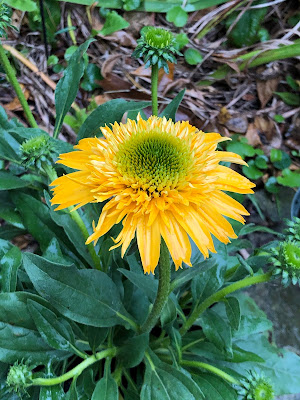

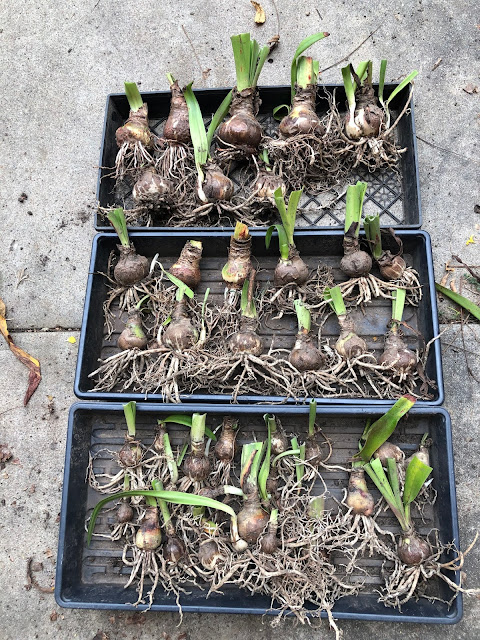


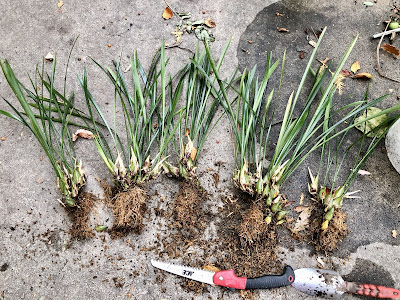






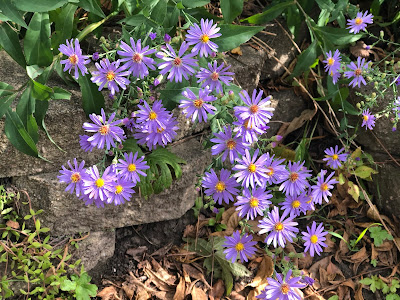

1 comment:
I don't think I've ever seen a yellow coneflower. It's wonderful! And so is that baking dish.
I miss the toad lilies we had in CT. They don't like Florida. Who can blame them?
Post a Comment